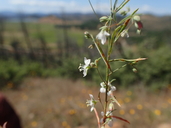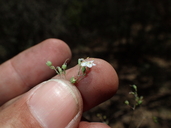Taxon Details
Hesperolinon didymocarpum
Lake County western flax
View Report Copy Link Calflora eFlora CCH CalPhotos iNaturalist
Taxon Summary:
Hesperolinon didymocarpum, commonly known as Lake County western flax, is a annual herb in the Linaceae that is found only in California. It occurs within Chaparral, Cismontane woodland, and Valley and foothill grassland, growing at elevations from 330 to 365 meters. Hesperolinon didymocarpum is ranked 1B.2, Plants Rare, Threatened or Endangered in California and Elsewhere; Moderately threatened in California.|
Scientific Name: Hesperolinon didymocarpum H.K. Sharsm. |
||
|
Common Name: Lake County western flax |
||
| Family: | Linaceae | |
| Element Code: | PDLIN01070 | |
| USDA Plants Symbol: | HEDI3 | |
|
Synonyms/Other Names: |
||
| Name Status: |
JEF, FNA, POWO, IPNI, Tropicos |
|
| CA Rare Plant Rank: | 1B.2 |
| Fed List: | None |
| State List: | CE (1981-08-01) |
| Global Rank: | G1 |
|
State Rank: |
S1 |
| Other Status: | BLM_S; SB_UCSC |
|
CRPR Changes: |
|
| Add Date: | 1974-01-01 |
| Date Edited: | 2024-11-05 |
| Lifeform: annual herb | ||||||||||||||
Blooming Period: May-Jul
|
||||||||||||||
|
Elevation:
330 - 365 meters 1085 - 1200 feet |
||||||||||||||
General Habitats:
|
||||||||||||||
| Microhabitat Details: | ||||||||||||||
Microhabitat:
|
||||||||||||||
| Threat List Total: | 5 | |
| Total EOs | % of EOs | |
| EOs with Threat Listed: | 4 | 67 % |
| THREAT LIST: | ||
|---|---|---|
| Grazing | 3 | 50% |
| Other | 1 | 16% |
| Recreational use (non-ORV) | 1 | 16% |
| Dam/Inundation | 1 | 16% |
| Erosion/runoff | 1 | 16% |
| Total Occurrences: | 6 | ||||
| Element Occurrence Ranks: | |||||
|---|---|---|---|---|---|
| A | B | C | D | X | U |
| 0 | 2 | 2 | 0 | 0 | 2 |
| Occurrence Status: | |||||
|---|---|---|---|---|---|
| Historical >20 Years | 5 | ||||
| Recent <=20 Years | 1 | ||||
| Presence: | |||||
|---|---|---|---|---|---|
| Presumed Extant | 6 | ||||
| Possibly Extirpated | 0 | ||||
| Presumed Extirpated | 0 | ||||
| California Endemic: | |||||||||||||
| California Island: | |||||||||||||
|
States: Name (Code) California (CA) |
|||||||||||||
|
California Counties and Islands: Name (Code) Lake (LAK) |
|||||||||||||
|
Quads: Name (Quad Code) Middletown (3812275) |
|||||||||||||
Notes:
|
|||||||||||||
 Presumed Extant
Presumed Extant
Click on quad for name. Hold Shift Key to use mouse scroll wheel



